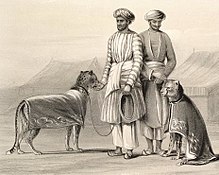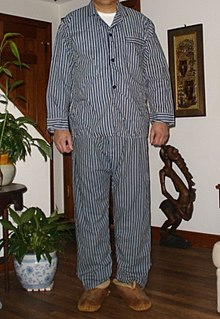Pajamas

A pajama or pajamas is a lightweight, two-piece usually robe to sleep is worn.
etymology
The word pajama comes from Dari-Persian (پايجامه pāy-jāma , literally " leg clothing") and originally denotes light trousers that are held together at the waist by a cord or cummerbund and are worn in South and West Asia, especially in India . The word found its way into English in the 19th century via the Hindustani ( Hindi पजामा pajāmā ) (here always as plural tantum : pajamas , also pajamas ) and was borrowed from there into German at the beginning of the 20th century, now with the meaning "pajamas". In Germany and Austria it is generally used as a masculine ( the pajama ) and pronounced [ ˌpyˈʤaːma ], in Switzerland it mostly appears as a neuter ( the pajama ) and with the sound [ ˌpiˈʤaːma ].
history
The British colonial rulers got to know this type of legwear in India . In the mid-17th century, the pajamas - both the word and the clothing - made their way through them to Europe , where for a short time it became fashionable as a leisure suit. After that, however, the new item of clothing fell into oblivion again in Europe. Only after 1870, with the increased trade between British India and the mother country, did pajamas return to Europe. A shirt-like top that could be buttoned was now worn with the light trousers. By the end of World War I , pajamas had largely replaced nightgowns , at least as nightwear for men. The very comfortable fabrics cotton and silk were suitable as materials , both of which became widely available through colonial trade in Europe.
In the 1930s, the fashion came up temporarily to wear light, wide trousers as so-called “beach pajamas” as female holiday clothing by the sea.
Today's pajamas consist of leg-length, wide-cut trousers and a long-sleeved top. In contrast to the past, this is often cut like a T-shirt and no longer has buttons. The pants are held around the waist by an elastic band. There are also versions with short sleeves or legs, but these are no longer pajamas in the true sense of the word. They are often referred to as a shorty .
Habits
Since pajamas are very comfortable, they are often worn as leisure suits at home. It is common not to wear any other clothing, especially underwear , with pajamas . Socks are occasionally worn in northern countries and when it is very cold. Surveys on the prevalence of pajamas as nightwear provide quite different numbers (see article sleep culture ).
In some areas, for example Shanghai , it became common from the 1970s to keep pajamas on in the neighborhood and also for shopping. For the 2010 World Exhibition , the Chinese government made great efforts to stop this “uncivilized” custom. The Chinese took over pajamas from the West, so to speak as a sign of prosperity and “coolness”, but did not understand the cultural context sufficiently. In England, the Tesco department store chain banned customers in pajamas.
Cultural history
One of the curiosities is that the German delegation met for a legendary “pajama conference” the night before the Rapallo Treaty was signed after the last Soviet proposals were received, in order to coordinate again before the treaty was signed.
In American day care centers and elementary schools, Pajama Day is occasionally held as a theme day , on which the students are allowed to appear in class in their pajamas.
Slumber parties are also occasionally held. You will spend the night with your host, hence the name of the pajamas.
Individual evidence
- ↑ Article PYJAMMAS, p. . In: Sir Henry Yule : Hobson-Jobson: A Glossary of Colloquial Anglo-Indian Words and Phrases, and of Kindred Terms, Etymological, Historical, Geographical and Discursive . J. Murray, London 1903, p. 748.
- ↑ Article pajamas . In: Broder Carstensen (Ed.): Anglicisms Dictionary: The Influence of English on German Vocabulary after 1945 . De Gruyter, Berlin 1996, Volume 1 ( PZ ), p. 1188.
- ↑ Pajamas . Encyclopædia Britannica Online. Retrieved September 8, 2009.
- ↑ a b Gao Yubing: The Pajama Game Closes in Shanghai . The New York Times . May 14, 2010. Retrieved September 10, 2010.
- ↑ Tesco ban on shoppers in pajamas . BBC. January 28, 2010. Retrieved September 10, 2010.
- ↑ Pajama Day

